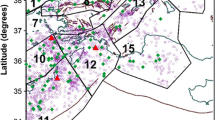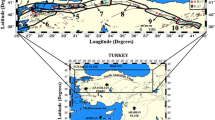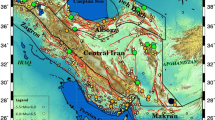Abstract
The Andaman–Nicobar–Sumatra (ANS) region is a very hazardous area on the globe, which has witnessed a megathrust earthquake of Mw 9.2 on 26 December 2004 and several dozen large earthquakes in the past. We estimate earthquake hazard parameters (i.e. seismic a- and b-values, maximum expected earthquake magnitudes, mean return periods and probabilities of earthquakes) in 11 shallow and 4 intermediate to deep depth seismogenic zones of the ANS region using a uniform and comprehensive earthquake data for the duration 1906–2018. The earthquake hazard scenarios for all seismogenic zones are calculated using the Gutenberg–Richter frequency–magnitude relation and the Gumbel’s extreme value theory. The low b-values (< 1.0) for both types of zones in the entire region suggest that the region is very active, under high stress and capable to generate large to great earthquakes. The estimated maximum magnitudes in different time periods using the extreme value theory show that shallow–depth zones 7, 8 and 11 (west to the Sumatra) have capabilities to generate an earthquake of magnitude Mw ≥ 8.0 in the next 50 and 100 years, while all intermediate to deep zones can generate magnitude less than 8.0. The mean return periods of earthquakes of magnitude Mw 7.0 in shallow zones 4–9 and 11 (the Sumatra and Nicobar Islands) exhibit less than 25 years. It is less than 80 years in shallow zones 4–11 for magnitude Mw 7.5, while higher return periods have been observed in the intermediate to deep zones (except for zone 4). The high probabilities (> 0.90) for the earthquake of Mw 7.0 in the next 50 years and 100 years are observed in shallow zones 4–11 (the Sumatra and Nicobar Islands), while only intermediate to deep zone 4 (Sumatra) shows high probabilities. The low return periods (< 25 years) and high probabilities (> 0.90) for the earthquake of Mw 7.0 are observed in shallow zones 5–11 (the Nicobar Islands and Sumatra regions), which suggest high earthquake hazard in these zones. The spatial variations of earthquake hazard parameters from one zone to another suggest a large grade of crustal heterogeneity and seismotectonic complexity present in this area.










Similar content being viewed by others
References
Båth M (1983) Earthquake frequency and energy in Greece. Tectonophysics 95(3–4):233–252. https://doi.org/10.1016/0040-1951(83)90070-7
Bayrak Y, Yilmazturk A, Oztrurk S (2005) Relationships between fundamental seismic hazard parameters for the different source regions in Turkey. Nat Hazards 36:445–462
Bayrak Y, Ozturk S, Cinar H, Koravos GCh, Tsapanos TM (2008) Regional variation of the x-upper bound magnitude of GIII distribution in and around turkey: tectonic implications for earthquake hazards. Pure appl Geophys 165:1367–1390
Beirlant J, Kijko A, Reynkens T, Einmahl JHJ (2019) Estimating the maximum possible earthquake magnitude using extreme value methodology: the Groningen case. Nat Hazards 98:1091–1113
Bilham R (2005) A flying start, then a slow slip. Science 308:1126–1127. https://doi.org/10.1126/science.1113363
BIS (2002) Indian standard criteria for earthquake resistant design of structures. Part 1—General provisions and buildings, IS 1893–2002. Bureau of Indian Standards, New Delhi
Burton PW (1979) Seismic risk in southern Europe through to India examined using Gumbel’s third distribution of extreme values. Geophys J Roy Astron Soc 59:249–280
Castellaro S, Mulargia F, Kagan Yan Y (2006) Regression Problems for Magnitude. Geophys J Int 165(3):913–930
Chingtham P, Yadav RBS, Chopra S, Yadav A, Gupta AK, Roy PNS (2016) Time-dependent seismicity analysis in the Northwest Himalaya and its adjoining regions. Nat Hazards 80(3):1783–1800
Coles S (2001) An introduction to statistical modelling of extreme values, 2nd edn. Springer, London
Dasgupta S, Mukhopadhyay B, Bhattacharya A (2007) Seismicity pattern in north sumatra-great Nicobar region: in search of precursor for the 26 December 2004 earthquake. J Earth Syst Sci 116(3):215–223
Engdahl ER, Van der Hilst R, Buland R (1998) Global teleseismic earthquake relocation with improved travel times and procedures for depth determination. Bull Seismol Soc Am 88:722–743
Epstein B, Lomnitz C (1966) A model for the occurrence of large earthquake. Nature 211:954–956
Fitch TJ (1970) Earthquake mechanism in the Himalaya, Burmese, and Andaman region and continental tectonic in the Central Asia. J Geophys Res 75(14):2699–2709
Gahalaut VK, Jade S, Catherine JK, Gireesh R, Ananda MB, Dileep Kumar P, Narsaiah M, Jafri SH, Ambikapathy A, Bansal A, Chadha RK, Gupta DC, Nagarajan B, Kumar S (2008) GPS measurements of postseismic deformation in the Andaman–Nicobar region following the giant 2004 Sumatra–Andaman earthquake. J Geophys Res 113:B08401. https://doi.org/10.1029/2007JB005511
Gui G, Baia Y, Wanga Z, Li T (2019) Seismic b-value anomalies in the Sumatran region: seismotectonic implications. J Asian Earth Sci 173:29–41
Gumbel EJ (1935) Les valeurs extremes des distribution statistiques. Ann Inst H Poincare 5:815–826
Gumbel EJ (1958) Statistics of extremes. Columbia University Press, New York, p 375
Gutenberg B, Richter CF (1956) Magnitude and energy of earthquakes. Ann Geofis 9:1–15
Kamesh Raju KA, Murty GPS, Amarnath D, Mohan Kumar ML (2007) The west Andaman fault and its influence on the aftershock pattern of the recent megathrust earthquakes in the Andaman–Sumatra region. Geophys Res Lett 34(3):L03305. https://doi.org/10.1029/2006GL028730
Kijko A (2004) Estimation of maximum magnitude Mmax. Pure appl Geophys 161(8):1655–1681
Kijko, A (2011) Seismic hazard in encyclopaedia of solid earth geophysics, vol 1, 1st edn. Gupta HK (eds) Springer, pp 1107–1120
Kijko A, Dessokey MM (1987) Application of the extreme magnitude distributions to incomplete earthquake files. Bull Seismol Soc Am 77(4):1429–1436
Kijko A, Sellevoll MA (1989) Estimation of earthquake hazard parameters from incomplete data files. Part I. Utilization of extreme and complete catalogs with different threshold magnitude. Bull Seismol Soc Am 79(3):645–654
Kijko A, Sellevoll MA (1992) Estimation of earthquake hazard parameters from incomplete data files. Part II. Incorporation of magnitude heterogeneity. Bull Seismol Soc Am 82(1):120–134
Kijko A, Singh M (2011) Statistical tools for maximum possible earthquake magnitude estimation. Acta Geophys 59(4):674–700
Knopoff L, Kagan Y (1977) Analysis of the theory of extremes as applied to earthquake problems. J Geophys Res 82:5647–5657
Kolathayar S, Sitharam TG (2012) Comprehensive probabilistic seismic hazard analysis of the Andaman-Nicobar regions. Bull Seismol Soc Am 102(5):2063–2076
Koravos GC, Yadav RBS, Tsapanos TM (2015) Evaluation of tsunami potential based on conditional probability for specific zones of the Pacific tsunamigenic rim. Tectonophysics 658:159–168
Lay T, Kanamori H, Ammon CJ (2005) The great Sumatra–Andaman earthquake of 26 December 2004. Science 308(5725):1127–1133
Lyubushin AA, Parvez IA (2010) Map of seismic hazard of India using Bayesian approaches. Nat Hazard 55(2):543–556
Lyubushin AA, Tsapanos TM, Pisarenko VF, Chkoravos G (2002) Seismic hazard for selected sites in Greece: a Bayesian estimation of seismic peak ground acceleration. Nat Hazard 52(1):89–98
Makropoulos KC, Burton WP (1985) Seismic hazard in Greece II ground acceleration. Tectonophysics 117:259–294
McCaffrey R (2009) The tectonic framework of the Sumatran subduction zone. Annu Rev Earth Planet Sci 3737(1):345–366
Mishra OP, Kayal JR, Chakrabortty GK, Singh OP, Ghosh D (2007) Aftershock investigation in the Andaman-Nicobar Islands of India and its seismotectonic implications. Bull Seismol Soc Am 97(1A):S71–S85
Mishra OP, Zhao D, Ghosh C, Wang Z, Singh OP, Ghosh B, Mukherjee KK, Saha DK, Chakrabortty GK, Gaonkar SG (2010) Role of crustal heterogeneity beneath Andaman–Nicobar Islands and its implications for coastal hazards. Nat Hazards 57:51–64. https://doi.org/10.1007/s11069-010-9678-3
Mukhopadhyay B, Mukhopadhyay M, Mishra OP et al (2018) Constraining the seismic potentiality analysis for Andaman arc system, NE Indian Ocean. J Geol Soc India 91:523–534
Nordquist JM (1945) Theory of largest values applied to earthquake magnitudes. Trans Am Geophys Union 26:29–31
Nuannin P, Kulhanek O, Persson L (2005) Spatial and temporal b-value anomalies preceding the devastating off coast of NW Sumatra earthquake of December 26, 2004. Geophys Res Lett 32:L11307
Nuannin P, Kulhanek O, Persson L (2012) Variations of b-values preceding large earthquakes in the Andaman–Sumatra subduction zone. J Asian Earth Sci 61:237–242
Ortiz M, Bilham R (2003) Source area and Rupture Parameters of the 31 December 1881 Mw = 79 Car Nicobar earthquake estimated from Tsunamis recorded in the Bay of Bengal. J Geophys Res Solid Earth 108(B4):2215. https://doi.org/10.1029/2002jb001941
Oztrurk S, Bayrak Y, Cinar H, Koravos GC, Tsapanos TM (2008) A quantitative appraisal of earthquake hazard parameters computed from Gumbel I method for different regions in and around Turkey. Nat Hazards 47:471–495
Pailoplee P (2017) Probabilities of earthquake occurrences along the Sumatra–Andaman subduction zone. Open Geosci 9:53–60
Pavlenko VA (2017) Estimation of the upper bound of seismic hazard curve by using the generalised extreme value distribution. Nat Hazards 89:19–33
Pavlenko VA, Kijko A (2019) Comparative study of three probabilistic method for seismic hazard analysis: case studies of Sochi and Kamchatka. Nat Hazard 97(2):775–791
Pisarenko VF, Rodkin MV (2017) The estimation of probability of extreme events for small samples. Pure appl Geophys 174(4):1547–1560
Pisarenko VF, Lyubushin LysenkoVB, Golubeva JV (1996) Statistical estimation of seismic hazard parameters: maximum possible magnitude and related parameters. Bull Seismol Soc Am 86(3):671–700
Pisarenko VF, Sornette A, Sornette D, Rodkin MV (2008) New approach to the characterization of mmax and of the tail of the distribution of earthquake magnitudes. Pure appl Geophys 165(5):847–888
Pisarenko VF, Sornette D, Rodkin MV (2010) Distribution of maximum earthquake magnitudes in future time intervals: application to the seismicity of Japan (1923–2007). Earth Planet Space 62:567–578
Reasenberg PA (1985) Second-order moment of central California seismicity. J Geophys Res 90:5479–5495
Reiter L (1990) Earthquake hazard analysis: issue and insight. Columbia Univ Press 22(3):254
Roy S, Ghosh U, Hazra S, Kayal JR (2011) Fractal dimension and b-value mapping in the Andaman–Sumatra subduction zone. Nat Hazards 57:27–37. https://doi.org/10.1007/s11069-010-9667-6
Scordilis EM (2006) Empirical global relations converting MS and mb to moment magnitude. J Seismol 10:225–236
Sengupta D, Mukhopadhyay B, Mishra OP (2018) Seismic cycles and trend predictions of earthquakes in Sumatra–Andaman and burmese subduction zones using temporal b-value and hurst analysis. J Geol Soc Ind 92:661–670
Sevilgen V, Stein RS, Pollitz FF (2012) Stress imparted by the great 2004 Sumatra earthquake shut down transforms and activated rifts up to 400 km away in the Andaman sea. PNAS 109(38):15152–15156
Shanker D, Yadav RBS, Singh HN (2007) On the seismic risk Hindukush–Pamir–Himalaya and their vicinity. Curr Sci 92(11):1625–1630
Singh AP, Murty TS, Rastogi BK, Yadav RBS (2012) Earthquake generated tsunami in the Indian Ocean and probable vulnerability assessment for the east coast of India. J Mar Geodesy 35:49–65
Srivastava K, Rani S, Srinagesh D (2015) A review of b-value imaging and fractal dimension studies in the Andaman Sumatra subduction. Nat Hazards 77:97–107
Subarya C, Chlieh M, Prawirodirdjo L, Avouac JP, Bock Y, Sieh K, Meltzner AJ, Natawidjaja DH, McCaffrey R (2006) Plate boundary deformation associated with great Sumatra Andaman earthquake. Nature 440(7080):46–51
Tinti S, Mulargia F (1985) Effects of magnitude uncertainties in the Gutenberg–Richter frequency–magnitude law. Bull Seismol Soc Am 75:1681–1697
Tsampas AD, Scordilis EM, Papazachos CB, Karakaisis GF (2016) Global-magnitude scaling relations for intermediate-depth and deep-focus earthquakes. Bull Seismol Soc Am 106:418–434. https://doi.org/10.1785/0120150201
Tsapanos TM (1997) Regional variation of the ω-values in the circum-Pacific belt. Pure appl Geophys 150(1):113–120. https://doi.org/10.1007/s000240050066
Tsapanos TM (1998) Seismic hazard for some regions of the world examined using strain energy release. J Balk Geophys Soc 1:19–26
Tsapanos TM (2001) Evaluation of the seismic hazard parameters for selected regions of the world: the maximum regional magnitude. Ann Geophys 44(1):69–79. https://doi.org/10.4401/ag-3615
Tsapanos TM (2003) Appraisal of seismic hazard parameters for the seismic regions of the east circum-Pacific belt inferred from a Bayesian approach. Nat Hazards 30:59–78
Tsapanos TM, Burton PW (1991) Seismic hazard evaluation for specific seismic regions of the world. Tectonophysics 194(1–2):153–169. https://doi.org/10.1016/0040-1951(91)90278-Z
Tsapanos TM, Christova CV (2003) Earthquake hazard parameters in Crete island and its surrounding area inferred from Bayes statistics: an integration of morphology of the seismically active structures and seismological data. Pure appl Geophys 160:1517–1536
Tsapanos TM, Galanis OCh, Koravos GCh, Musson RMW (2002) A method for Bayesian estimation of the probability of the local intensity for some cities of Japan. Ann Geophys 45:657–671
Tsapanos TM, Bayrak Y, Cinar H, Koravos GC, Bavrak E, Kalogirou EE (2014) Analysis of largest earthquake in Turkey and its vicinity by application of the Gumbel III distributions. Acta Geophys 62(1):59–82
Tsapanos TM, Yadav RBS, Olasoglou EM, Singh M (2016) Assessment of the relative largest earthquake hazard level in the NW Himalaya and its adjacent region. Acta Geophys 64(2):362–378
Udias A (1999) Principles of seismology. Cambridge University Press, New York
Van Veen BAD, Vatvani D, Zijl F (2014) Tsunami flood modelling for Aceh and west Sumatra and its application for an early warning system. Cont Shelf Res 79:46–53
Vermeulen P, Kijko A (2017) More statistical tools for maximum possible earthquake magnitude estimation. Acta Geophys 65:579–587
Weatherill GA, Pagani M, Garcia J (2016) Exploring earthquake databases for the creation of magnitude-homogeneous catalogues: tools for application on a regional and global scale. Geophys J Int 206:1652–1676. https://doi.org/10.1093/gji/ggw232
Wessel P, Smith WHF (1995) new version of the generic mapping tools released, EOS. Trans Am Geophys Union 76:329
Wiemer S, Wyss M (2002) Mapping spatial variability of the frequency of magnitude distributions of earthquake. Adv Geophys 45–295 V
Woessner J, Wiemer S (2005) Assessing the quality of earthquake catalogues: estimating the magnitude of completeness and its uncertainty. Bull Seismol Soc Am 95(2):684–698
Yadav RBS, Shanker D, Chopra S, Singh AP (2010a) An application of regional time and magnitude predictable model for long-term earthquake prediction in the vicinity of October 8 2005 Kashmir Himalaya earthquake. Nat Hazards 54(3):985–1014
Yadav RBS, Tripathi JN, Rastogi BK, Das MC, Chopra S (2010b) Probabilistic assessment of earthquake recurrence in Northeast India and adjoining region. Pure appl Geophys 167(11):1331–1342
Yadav RBS, Tripathi JN, Shanker D, Rastogi BK, Das MC, Kumar V (2011a) Probabilities for the occurrences of medium to large earthquakes in Northeast India and adjoining region. Nat Hazards 56:145–167
Yadav RBS, Papadimitriou EE, Karakostas VG, Shanker D, Rastogi BK, Chopra S, Singh AP, Santosh K (2011b) The 2007 Talala, Saurashtra, western India earthquake sequence: tectonic implications and seismicity triggering. J Asian Earth Sci 40(1):303–314
Yadav RBS, Bayrak Y, Chopra TripathiJN, Bayrak SE (2012a) Regional variation of the w-upper bound magnitude of GIII distribution in Hindukush–Pamir Himalaya and the adjacent regions: a perspective on earthquake hazard. Tectonophysics 544–545:1–12
Yadav RBS, Bayrak Y, Tripathi JN, Chopra S, Singh AP, Bayrak E (2012b) A probabilistic assessment of earthquake hazard parameters in NW Himalaya and the adjoining regions. Pure appl Geophys 169:1619–1639
Yadav RBS, Gahalaut VK, Chopra S, Shan B (2012c) Tectonic implications and seismicity triggering during the 2008 Baluchistan, Pakistan earthquake sequence. J Asian Earth Sci 45(2):167–178
Yadav RBS, Tripathi JN, Kumar S (2013a) Probabilistic assessment of tsunami recurrence in the Indian Ocean. Pure appl Geophys 170(3):373–389
Yadav RBS, Tsapanos TM, Tripathi JN, Chopra S (2013b) An evaluation of tsunami hazard using Bayesian approach in the Indian Ocean. Tectonophysics 593:172–182
Yadav RBS, Tsapanos TM, Koravos GCH, Bayrak Y, Devlioti KD (2013c) Spatial mapping of earthquake hazard parameters in the Hindukush–Pamir himalaya and adjacent regions: a perspective on future hazard. J Asian Earth Sci 70:115–124
Yadav RBS, Koravos GCH, Tsapanos TM, Vougiouka EG (2015) A probabilistic estimate of most perceptible earthquake magnitudes in the NW Himalaya and adjoining regions. Pure appl Geophys 172(2):197–212
Acknowledgements
The authors from Kurukshetra University are thankful to their institute for support to carry out this work. The Generic Mapping Tools system, version 4.5.5 (Wessel and Smith 1995), was used to plot the figures. The authors are grateful to Prof H. K. Gupta, the Editor-in-Chief and two anonymous reviewers for their generous comments and suggestions that improved the quality of the manuscript.
Author information
Authors and Affiliations
Corresponding author
Additional information
Publisher's Note
Springer Nature remains neutral with regard to jurisdictional claims in published maps and institutional affiliations.
Rights and permissions
About this article
Cite this article
Mishra, M., Abhishek, Yadav, R.B.S. et al. Probabilistic assessment of earthquake hazard in the Andaman–Nicobar–Sumatra region. Nat Hazards 105, 313–338 (2021). https://doi.org/10.1007/s11069-020-04311-2
Received:
Accepted:
Published:
Issue Date:
DOI: https://doi.org/10.1007/s11069-020-04311-2




